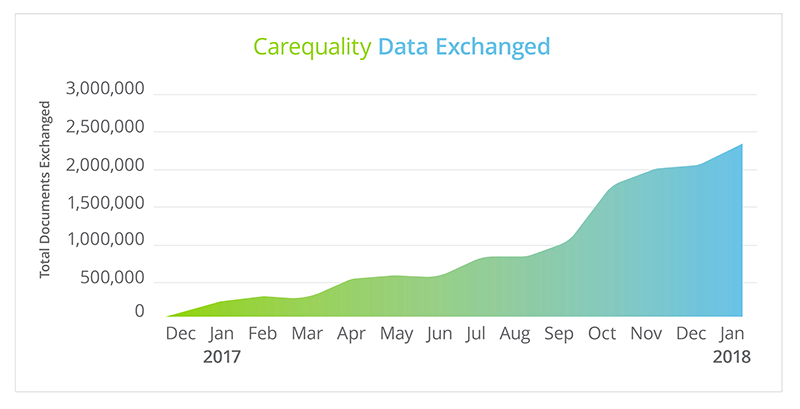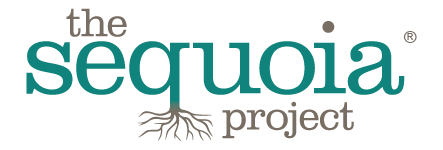600,000+ Physicians exchanging more 2.4 million clinical documents per month under Carequality
(Vienna, VA – February 28, 2018) – Carequality, an initiative of The Sequoia Project, reported today that the traction and growth of its national-level trusted exchange framework is fueled by a straightforward process, which focuses on the key essentials for interoperability. To date, more than 1,250 hospitals, 35,000 clinics, and 600,000 health care providers are connected through the Carequality interoperability framework.

“What’s so exciting about the Carequality framework is its inclusiveness and flexibility,” said Dave Cassel, vice president of Carequality. “In about a year and a half, we’ve gone from a good concept, to a critical mass of nationwide exchange among diverse organizations. The speed with which this has occurred isn’t something we’re accustomed to from interoperability projects, historically.”
Nine pioneering Carequality members are live now, including athenahealth®, eClinicalWorks, Epic, GE Healthcare, Netsmart, NextGen Healthcare, OneRecord, Santa Cruz HIE, and Surescripts. Exchange has rapidly increased over the first year and a half of operation, with over 2.4 million clinical documents now being exchanged monthly across these organizations and their customers. Organizations leveraging this unique framework may dramatically expand connectivity of their existing network, providing their own clients new health data sharing options.
“Successfully delivering historical patient care information requires strong cross-market network alliances, which are in place and rapidly expanding. Surescripts Record Locator and Exchange went live on the Carequality framework in 2016, immediately delivering value to increasingly consumer-minded patients by building trust with their care teams who now have the breadth of their medical information in hand,” said Tom Skelton, Chief Executive Officer of Surescripts. “In just the last three months of 2017, we exchanged more than four million clinical documents with Carequality participants, effectively relieving the burden on patients and their loved ones to recall their clinical history and saving significant time by eliminating the need for support staff to manually field records requests.”
2017 Live Sites

2018 Live Sites

Cassel credits the role of the participating networks in achieving wide rollouts in a relatively short time. “We could never have seen the scope of rollout that has occurred so far, without well-established data sharing networks and programs being in place. They’ve done all the hard work of getting their members and customers wired in. What Carequality adds are the elements for the networks to take that individual success and compound it together. In the end, it comes down to trust, which stems from the contractual governance but is validated through solid onboarding processes.”
“In order to deliver on the promise of interoperability, the industry needs to collaboratively create user-friendly solutions that provide universal access to health information,” said Evan Grossman, Vice President of Integration Services at athenahealth. “Through our partnerships with Carequality and other major networks, athenahealth is able to give providers the ubiquitous access that they need to gain a comprehensive view of their patients’ care. By utilizing a single gateway architecture, athenahealth clients need no special on-site configuration. athenahealth can build and scale our network connections in the background, giving providers easy access to thousands of care sites directly in their EHR workflow. Through our work with Carequality, providers can access the right information at the right time and are enabled to feel present and prepared in each patient’s moment of care.”
In addition to the regional health information exchange, record locator service, personal health and electronic health record (EHR) vendors live now, eighteen other organizations have signed on to be implementers of the Carequality framework. Those in the onboarding process now include new kinds of service providers, consumer apps, and additional EHR vendors and HIEs.
“Before Carequality, the healthcare industry struggled to achieve true care coordination, particularly when it came to integrating behavioral health and post-acute data, which accounts for nearly 20 percent of healthcare spending, with the rest of healthcare,” said Netsmart CEO Mike Valentine. “This national framework provides real-time access to information from all healthcare settings and improves outcomes by empowering whole-person care; which is vital to bending the cost curve of treating a population that is more likely to have multiple chronic conditions and are some of the most expensive group to treat in healthcare.”
More than 50% of all health care providers in the country are now empowered to share health data under the Carequality Interoperability Framework. However, Carequality was designed to be largely invisible to physicians and other individual users. “Our goal is to make national-scale interoperability easily accessible for provider organizations and other stakeholders,” Cassel explained. “If we’ve done our job well, users won’t even know we exist; they’ll just see improved capabilities within their home systems or networks.”
“We’ve found that seamless integration of external clinical data into the GE Healthcare workflow is saving our customers time, and sharing data in real-time helps the healthcare community enhance care quality for shared patients and avoid unnecessary medical expense, “ said Jon Zimmerman, Vice President and General Manager of Value-Based Care Solutions at GE Healthcare. “Our cloud-based approach enables our customers to take full advantage of the rapidly growing Carequality.”
